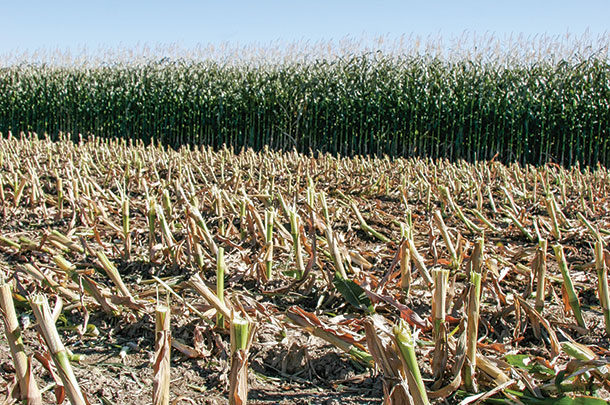The shredlage processor rips the forage longitudinally, opens up the rind of the plant and smashes the corn kernels, resulting in higher corn silage processing scores (CSPS) than conventionally processed corn silage. In recent years, studies have found varying responses to feeding shredlage.
In order to help the farm make a decision on how to proceed in the future with corn silage processing, we worked with the farm to design a project to compare the corn silage harvested on the farm as shredlage or with a conventional corn silage processing unit.
The farm’s nutrition consultants formulated diets to have 22.4 pounds (38 percent of diet dry matter) of dry matter (DM) from either conventionally processed corn silage or shredlage.
All other ingredients in the diet were the same: 7.9 pounds of DM haylage, 28 pounds DM premixed concentrate and 0.8 pounds of DM whey for a total of 59.1 pounds DM. Diets were fed to two pens of two-plus-lactation cows with 152 cows per pen. The cows in the conventional pen (C pen) averaged 120 days in milk (DIM), and the cows in the shredlage pen (S pen) averaged 115 DIM at the start of the project.
Results
Over the 12 weeks of the study, 136 cows were in the pen for all 12 weeks when conventionally harvested corn silage was fed, and 143 cows in the pen were fed shredlage. Health events recorded in the shredlage pen were: five for mastitis, nine for feet problems and one for pneumonia. In the conventionally processed corn silage pen, nine cases of mastitis and 14 feet problems were recorded.
Forage analysis was very similar between weeks three and nine (Table 1); therefore, DM intake and milk production in the two pens is focused on these weeks.

DM intake was similar between weeks three and nine, averaging 56 pounds per cow per day (plus-or-minus 1.2) on the shredlage diet and 55.8 pounds per cow per day (plus-or-minus 1.2) on the conventional corn silage diet.
Milk production was 2.2 to 3.2 pounds per day higher for the shredlage diet than the conventional corn silage diet (Figure 1).

The similarity of chemical analysis for shredlage and conventional corn silage with different milk production responses leads to the second objective of the project – to examine other methods for evaluating corn silage.
Milk quality did not differ between diets at six weeks or 12 weeks. In week six, fat percent averaged 3.69 (plus-or-minus 0.78), protein percent averaged 3.03 (plus-or-minus 0.42), somatic cell count (SCC) x 1,000 averaged 61.5 (plus-or-minus 208), and milk urea nitrogen (MUN) mg per dL averaged 13 (plus-or-minus 2.2).
In week 12, fat percent averaged (3.71 plus-or-minus 0.67), protein percent averaged 3.09 (plus-or-minus 0.33), SCC x 1,000 averaged 81.9 (plus-or-minus 214,) and MUN mg per dL averaged 13 (plus-or-minus 2). None of the previous shredlage studies have reported any difference in milk quality measures when shredlage was fed.
During week six and week 12, TMR and orts samples were analyzed with the Penn State Shaker Box, and no evidence of sorting was seen. As with milk quality, there have been no other shredlage studies that have reported any sorting of shredlage diets.
Fecal starch was 2 percent or less, indicating very good starch digestion in both diets and no difference between treatments.
In week six, fecal starch averaged 2.18 percent (plus-or-minus 1.16) DM and 1.95 percent DM (plus-or-minus 0.78) for the S Pen and the C pen, respectively. In week 12, fecal starch was 1.46 percent DM (plus-or-minus 0.64) and 1.66 percent DM (plus-or-minus 0.86) for the S Pen and the C pen, respectively.

Other studies have not reported differences in total tract starch digestibility when cows were fed shredlage.
The percentage of material on the top screen of the Penn State Shaker Box was higher for shredlage (36.8 percent) than conventional corn silage (13.9 percent). The CSPS averaged 62.2 (plus-or-minus 2.8) for shredlage and 56.2 (plus-or-minus 4) for the conventional corn silage.
However, milk production in the study was not correlated with the CSPS results. We found better relationships to milk production when we measured the starch and neutral detergent fiber concentrations in the fractions of the CSPS and plan to further explore these measures in 2016.
Overall results of this project were similar to what has been reported in other studies. Milk quality measures were not different, cows did not sort diets, and fecal starch was not different. Milk production response in this study was greater than reported in other studies. FG
For a complete report, contact Sally Flis or at (607) 229-5337.
Acknowledgements: Thank you to the Allenwaite farm and staff, Sue Greth and Russ Saville from Cargill Animal Nutrition, the Dairy One Forage Lab staff, Dairy One DHIA technicians, and Heather Dann, Ph.D., of the William H. Miner Agricultural Research Institute.
PHOTO: Shredlage field. Photo by PD staff.
Sally Fils is a feed and crop support specialist with Dairy One. Email Sally Files.










